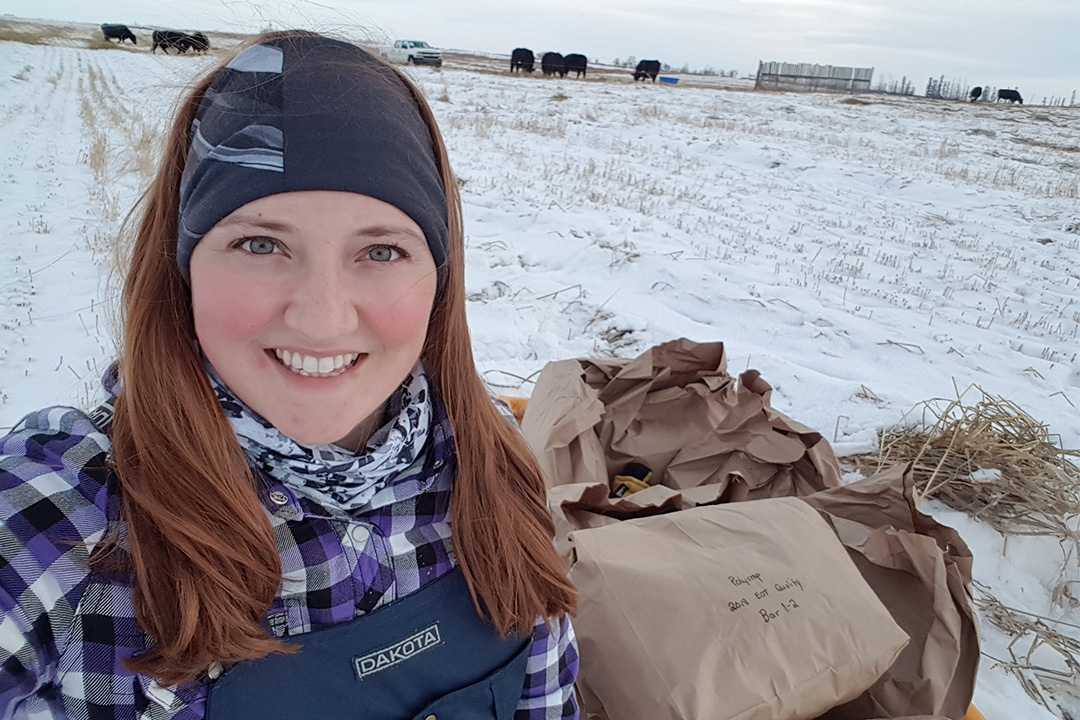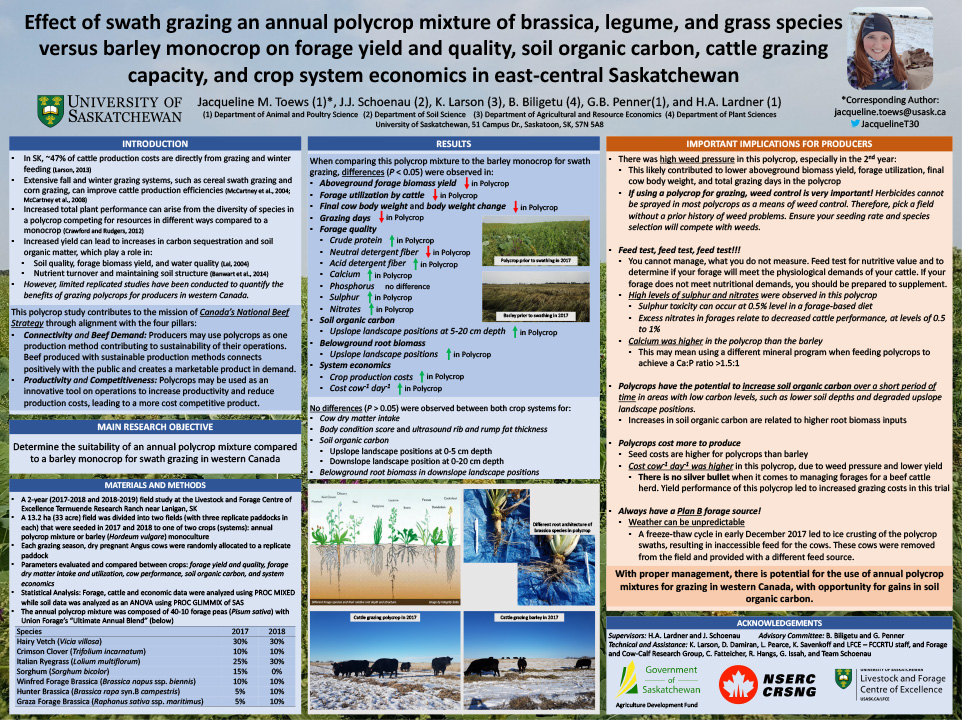
Annual polycrop is compared to barley in a USask research study
Growing an annual polycrop for beef cattle isn’t a silver bullet to extend grazing, but producers may still see some benefits when the crop is managed properly, according to research conducted at the Livestock and Forage Centre of Excellence.
By Lana HaightThere has been a lot of “buzz” in the beef cattle industry surrounding the benefits of polycrops, says Jacqueline Toews, a Master of Science candidate at the University of Saskatchewan’s College of Agriculture and Bioresources. She is co-supervised by animal scientist and professor Dr. Bart Lardner (PhD) and soil scientist and professor Dr. Jeff Schoenau (PhD).
“Producers are being told that annual polycrops can lead to increased yields and overall lower feeding costs than traditional monocrop cereal swath grazing. Polycrops are being marketed as the next best thing for cattle producers to be incorporating on their operations, but there wasn’t a lot of scientific ground-truthing behind the claims,” said Toews, who is in the process of writing her master’s thesis.
In the spring of 2017 and again in 2018, half of a 33-acre (13.2 ha) field at Termuende Ranch located near Lanigan, Sask., was seeded with a polycrop that included forage peas, hairy vetch, crimson clover, Italian ryegrass, sorghum and three types of brassicas. Each year, the other half was seeded to barley.
The fields were swathed in the fall and each was divided into three paddocks where groups of cattle grazed into the winter. Throughout the grazing period, the animals were weighed regularly to monitor the weight they gained based on their diet, comparing the cattle grazing on barley swaths to those grazing on the annual polycrop swaths.
Toews looked at the benefits beyond weight gain. She also compared crop yield and forage quality as well as soil organic carbon and nitrogen. Finally, Toews compared how much each crop cost to seed and how long the animals grazed in the two fields.

“We were able to look at the annual polycrop with a systems approach, rather than individual pieces. My project was able to evaluate everything from forage quality, soil health parameters, and cattle performance to how much these systems cost. At the end of the day, a producer is going to use grazing and feed systems that make sense financially,” said Toews.
| POLYCROP | BARLEY | |
| Crude protein (average) | 14 per cent | 10 per cent |
| Calcium to phosphorus (ratio should be greater than 2 to 1) |
4.4 to 1 | 1 to 1.2 |
| Yield (average) | 7.1 T ha-1 | 9.8 T ha-1 |
| Grazing days | 37.0 | 64.8 |
Toews attributes the lower polycrop yield to high weed pressure, including pigweed and kochia, that couldn’t be sprayed in the field. The barley field was sprayed. She identified weather, in addition to the weeds, for the reduced number of grazing days in the polycrop. When freezing and thawing in December 2017 led to ice crusting on the polycrop swaths, the cattle were moved off the field, but cattle were still able to feed off the bulky barley swaths that didn’t have the same ice build-up.
The bottom line for producers showed the annual polycrop cost more because the seed was more expensive than barley, the crop was seeded in two stages and the animals had fewer grazing days. In the end, it cost $1.35 per day more for each animal that was grazing on the polycrop.
Beyond the immediate dollars and cents, growing polycrops in a rotation is good for soil health: improving soil organic matter, forage biomass yield, and water quality; increasing nutrient turnover; and maintaining soil structure. All of this has the potential to increase future crop yields.
Management is key when seeding polycrops, says Toews. She recommends selecting a field that is relatively weed free, seeding at a high seeding rate, testing the feed to ensure it meets the nutritional requirements of the cattle, and have a plan B in case the weather interferes with the winter grazing season.
Toews is a business agronomist with Cavalier Agrow/G-Mac's AgTeam, based in Spiritwood, Sask.
This research was funded by Saskatchewan’s Agriculture Development Fund and National Sciences and Engineering Research Council of Canada.
USask’s Livestock and Forage Centre of Excellence is a world-class complex of field and science laboratories that brings together under one roof every link of the livestock production chain, promoting a systems approach. Modelling all aspects of raising livestock on the Canadian Prairies, it is a powerhouse for innovative research, teaching and industry engagement.
View original article on lfce.usask.ca.

